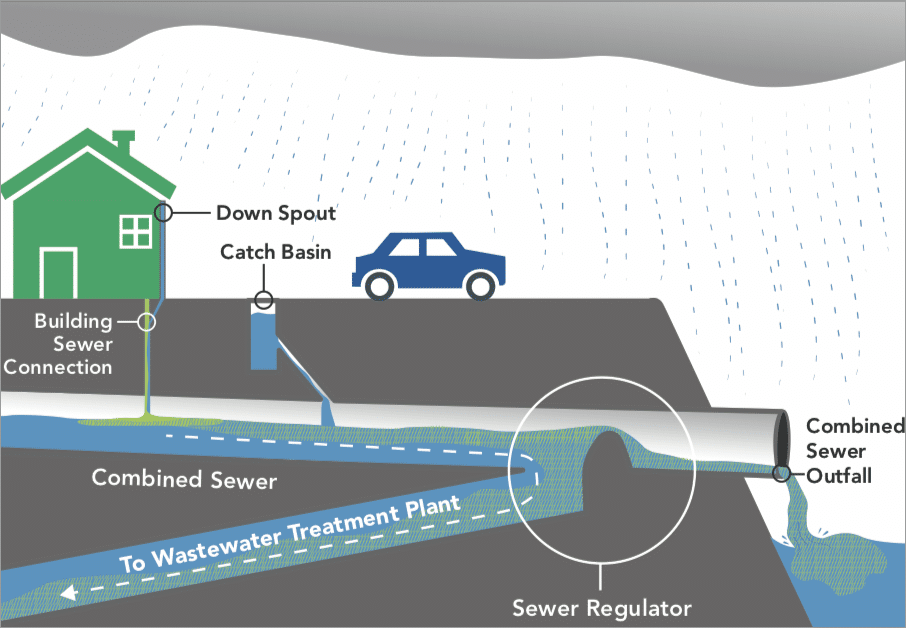Wastewater management is a critical aspect of urban infrastructure, and the choice between combined and separate sewerage systems plays a pivotal role in shaping a city’s sanitation strategy. Both systems are designed to handle the collection and transportation of wastewater, but they differ significantly in their approach to managing stormwater. In this article, we will explore the distinctions between combined and separate sewerage systems, their advantages, and the challenges they present.
Combined Sewerage Systems:
Integration of Wastewater and Stormwater: The defining characteristic of combined sewerage systems is the integration of both wastewater and stormwater into a single network of pipes. In this system, rainwater runoff from streets, roofs, and other surfaces is collected alongside domestic, industrial, and commercial wastewater.
Treatment at a Centralized Facility: Combined sewerage systems channel both wastewater and stormwater to centralized treatment facilities. Here, the combined flow undergoes various treatment processes to remove pollutants and contaminants before being discharged into receiving water bodies or reused for non-potable purposes.
Efficiency in Resource Utilization: One of the advantages of combined sewerage systems lies in their efficient use of infrastructure. By consolidating the transportation and treatment of both wastewater and stormwater, these systems can optimize resources. Reducing the need for separate networks and treatment plants.
Challenges in Peak Flows: However, combined sewerage systems face challenges during heavy rainfall or storm events. The simultaneous influx of wastewater and stormwater can overwhelm the capacity of the system, leading to combined sewer overflows (CSOs). CSOs release untreated or partially treated water into water bodies, posing environmental and public health risks.
Risk of Urban Flooding: The integration of stormwater and wastewater may also result in increased urban flooding during intense rainfalls. The system’s capacity may be exceeded, leading to the backup of water into streets and basements. Managing peak flows becomes a crucial aspect of the design and operation of combined sewerage systems.
Separate Sewerage Systems:
Distinct Networks for Wastewater and Stormwater: In contrast, separate sewerage systems maintain two distinct networks—one for wastewater and another for stormwater. Wastewater from homes, businesses, and industries is conveyed through one set of pipes. While stormwater runoff is collected separately and directed to stormwater drains.
Specialized Treatment: Wastewater from separate sewerage systems is treated at dedicated wastewater treatment plants. This approach allows for a focused and optimized treatment process. Ensuring the thorough removal of pollutants and contaminants from domestic and industrial sources.
Reduced Risk of Overflows: Separate sewerage systems minimize the risk of combined sewer overflows since stormwater is not mixed with wastewater in the same pipes. This separation enhances the effectiveness of treatment processes and reduces the environmental impact of urban runoff.
Better Control of Peak Flows: By keeping wastewater and stormwater separate, these systems offer better control over peak flows. Stormwater management components such as detention basins and retention ponds are designed to handle excessive rainwater runoff. Preventing flooding and reducing the strain on the sewer system.
Flexibility in Expansion: Separate sewerage systems provide flexibility in expanding and upgrading infrastructure. The distinct networks allow for targeted improvements in response to changes in urban development and population growth without requiring significant modifications to existing systems.
Considerations and Challenges:
Urban Planning and Development: The choice between combined and separate sewerage systems often depends on factors such as existing infrastructure, land use patterns, and the topography of the area. Urban planners must carefully consider these factors to determine the most suitable system for a given location.
Costs and Maintenance: The costs associated with the construction and maintenance of sewerage systems are critical considerations. While combined systems may offer efficiency in resource utilization, separate systems may be more cost-effective in certain contexts. Especially when expansion and upgrades are required.
Environmental Impact: Both systems have environmental implications. Combined systems, if not managed properly, may contribute to water pollution during overflow events. On the other hand, separate systems may require additional infrastructure to manage stormwater. Contributing to land use challenges and potential ecological impacts.
Conclusion:
The choice between combined and separate sewerage systems involves a careful balancing act of efficiency, environmental impact, and adaptability to urban development. Each system comes with its own set of advantages and challenges, and the decision must align with the specific needs and characteristics of the urban landscape. As cities continue to evolve, innovative approaches and technologies may offer opportunities to address. The challenges associated with both combined and separate sewerage systems. Ultimately contributing to more sustainable and resilient urban environments.

